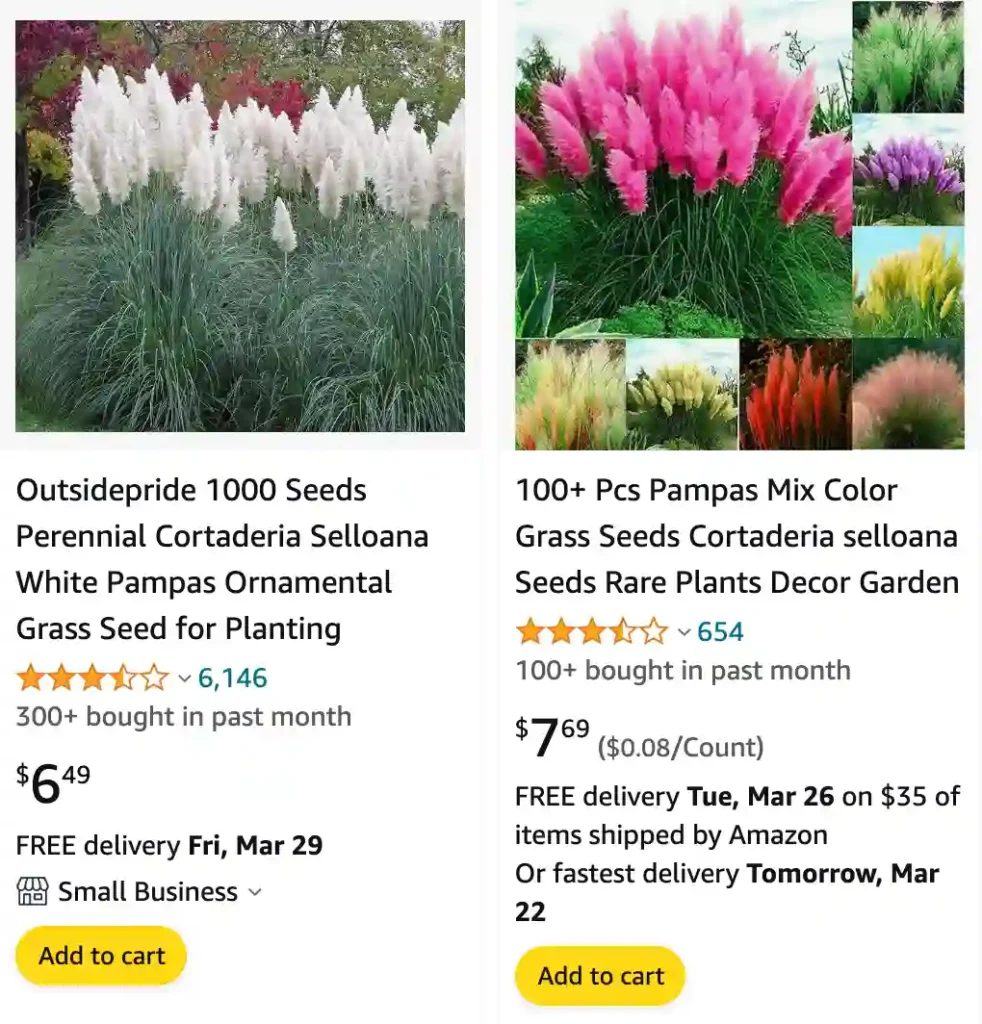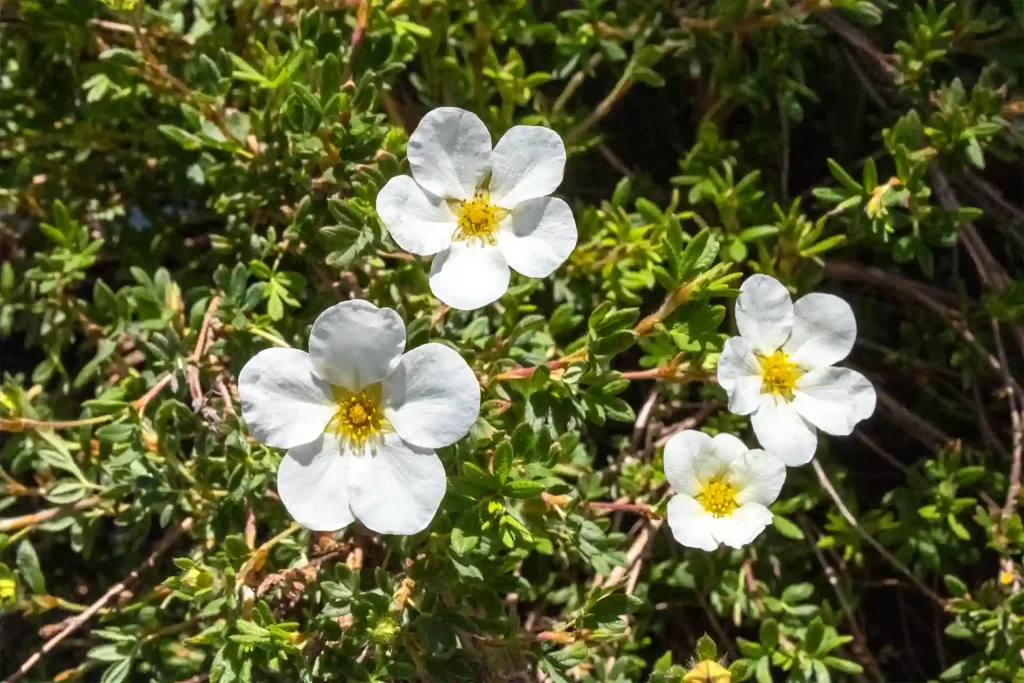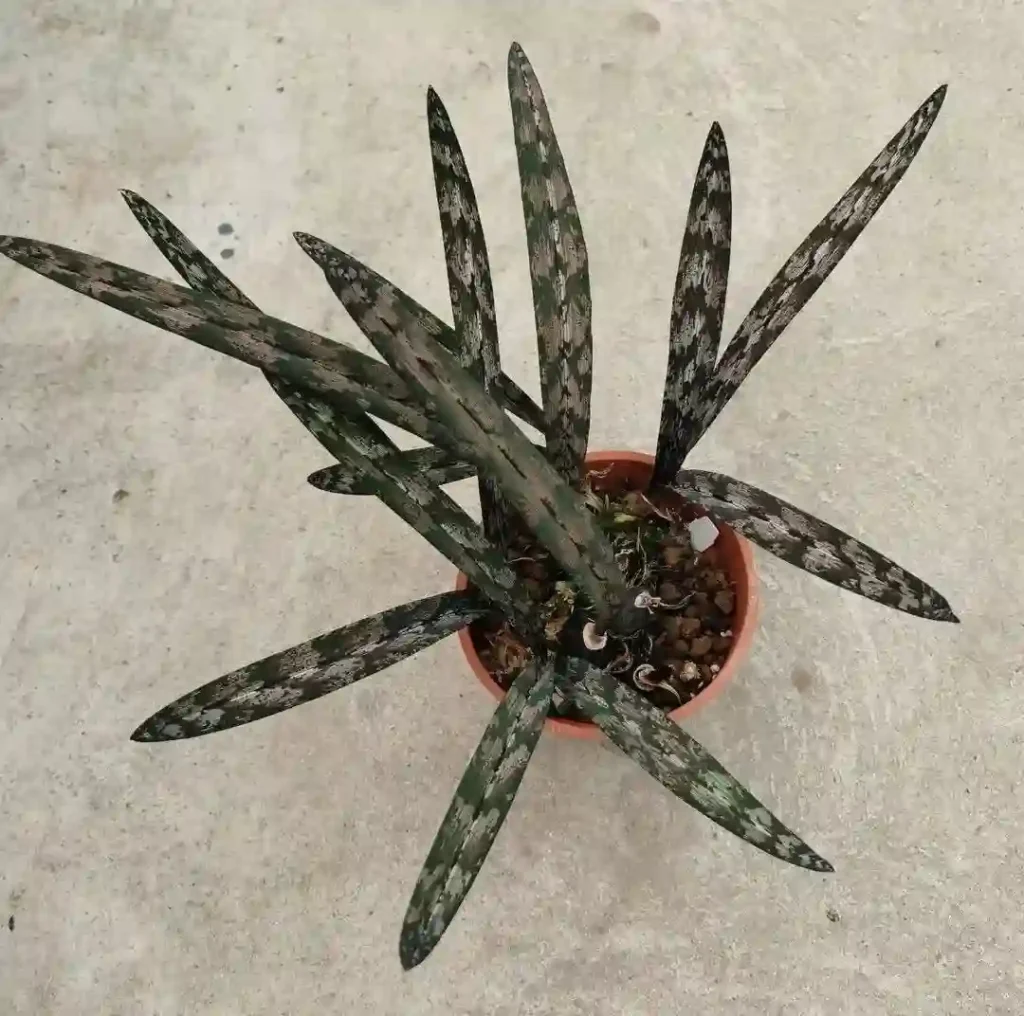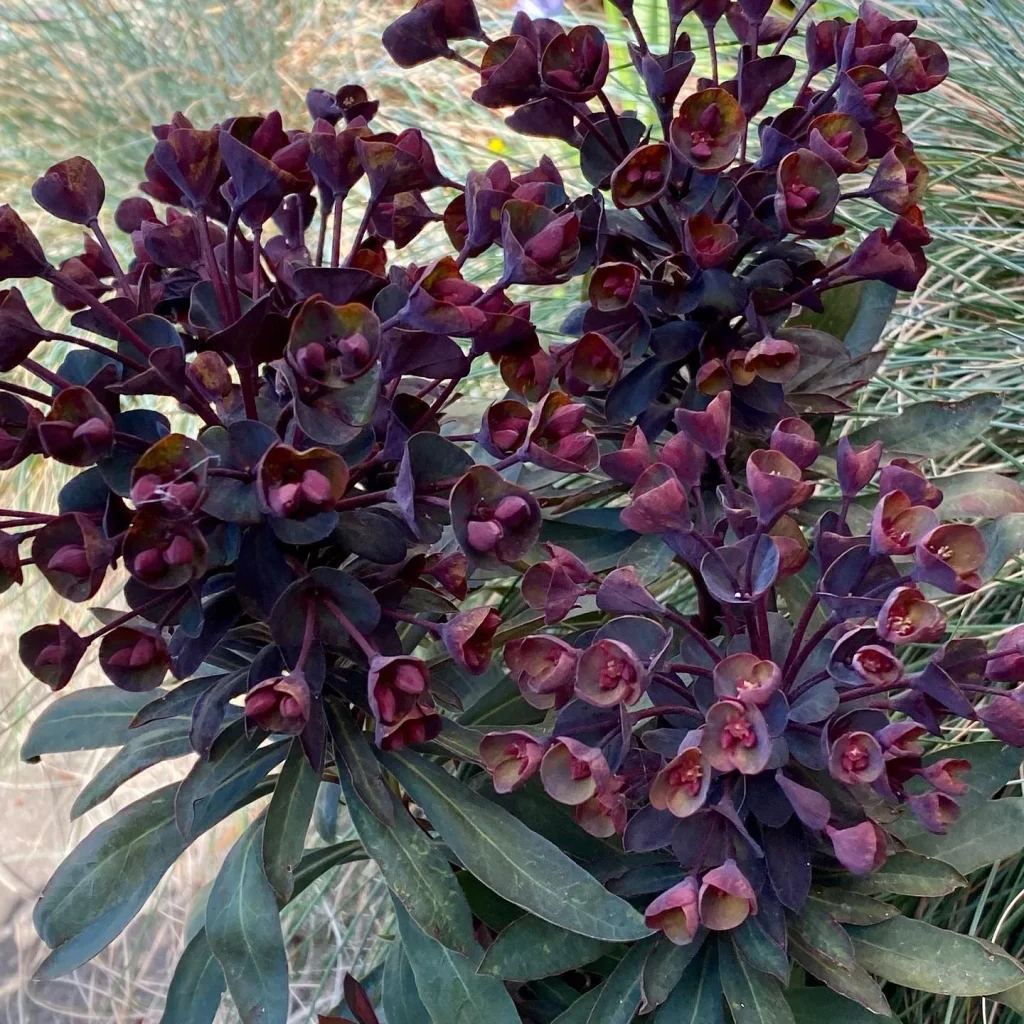
What do pampas grass seeds look like?
I never realized how tiny pampas grass seeds(Cortaderia Selloana) were until I tried collecting them myself. They’re like little slivers of dark brown, maybe a hair longer than a grain of rice. They’re attached to these feathery parts of the bloom, and they come loose way too easily. It was like trying to catch dandelion fluff in a gentle breeze! I ended up with more itchy straw-like stuff in my gloves than actual seeds. Next time, I’m definitely buying a seed packet instead!
Pampas Grass vs Fountain Grass
When it comes to Pampas Grass versus Fountain Grass, I find Fountain Grass to be more delicate and graceful in appearance, while Pampas Grass has a bold and dramatic presence that can be quite striking in a landscape.
Pampas Grass vs Maiden Grass
Comparing Pampas Grass with Maiden Grass, I prefer Maiden Grass for its more refined and elegant growth habit. It adds a softer texture and doesn’t dominate the space as much as Pampas Grass.
Pampas Grass vs Miscanthus
Pampas Grass versus Miscanthus is a tough choice, but I lean towards Miscanthus for its versatility and the variety of cultivars available. It offers a more nuanced aesthetic with its feathery plumes and varying heights.
Pampas Grass vs Phragmites
In terms of invasiveness, Pampas Grass versus Phragmites, I’ve found Phragmites to be more problematic in some regions due to its aggressive spreading nature, whereas Pampas Grass, while still potentially invasive, is more manageable with proper care and containment.
Pampas Grass vs Sea Oats
Pampas Grass versus Sea Oats is interesting; I appreciate Sea Oats for its coastal resilience and graceful arching stems, which can withstand seaside conditions better than Pampas Grass.
Pampas Grass vs Toi Toi
Lastly, comparing Pampas Grass with Toi Toi, I admire Toi Toi for its distinctive feathery plumes and compact growth habit, making it suitable for smaller spaces where Pampas Grass might overwhelm the area.
Is pampas grass invasive? Why is pampas grass bad?
I can’t speak for everywhere, but pampas grass seems to be a real problem around here. It looks amazing in those big fluffy clumps, but I’ve heard horror stories about it spreading like crazy. My neighbor down the street has some, and it’s already taken over half his flowerbed! He’s constantly battling to keep it in check. Apparently, the seeds travel on the wind for miles, and once they get established, they crowd out everything else. Seems like a pretty bad deal for the native plants that were there first. Maybe that’s why I see signs at the garden center warning people about planting it. Too pretty for its own good, I guess!
Where to buy pampas grass?
There are actually a couple of ways to go about getting pampas grass, depending on what you’re looking for. If you want the instant gratification of beautiful plumes in your home right now, online retailers and craft stores are a great option. I’ve seen them on [place where you’ve seen pampas grass for sale, e.g., Amazon] before, and they come in all sorts of colors – natural, bleached white, even pink!
However, if you’re looking for a more hands-on experience (and maybe a slightly cheaper option), trying a local garden center might be the way to go. You might not find the pre-dried plumes, but they could have live plants or even seeds. I know some nurseries around here carry them, but it can be hit or miss depending on the season. It wouldn’t hurt to call ahead and see what they have in stock!
How to cut pampas grass?
Cutting pampas grass can be a bit of a prickly task, literally! I learned the hard way that you definitely want some good gloves – those feathery plumes are hiding sharp edges. Loppers or a sharp pair of pruning shears are best, since the stems can be quite thick. I tried using regular gardening shears once, and let’s just say it wasn’t pretty.
The timing is important too. Wait until late fall or early winter, after the plumes have dried out completely. If you cut them too early, they won’t hold their shape as well. Then, I usually tie the leaves up loosely above where I’m going to cut – this helps keep everything contained and prevents a shower of itchy straw when you make the cut. Just be careful not to tie them too tight, or you might accidentally damage the new growth at the base. Cut the stems a few inches above the base of the plant, and dispose of the cuttings carefully – those seeds are sneaky travelers!
How to fluff pampas grass?
My pampas grass always arrives looking a bit flat and lifeless after being shipped. But there are a couple of tricks I’ve learned to bring back their fluff and fullness. First, a gentle shake outside can work wonders. I hold the stem upside down and give it a few flicks – this loosens up the plumes and lets them separate a bit more naturally. Be warned, some shedding is totally normal, so maybe do this outside or over a newspaper.
For a more dramatic effect, I like to use my hairdryer on a cool setting. I hold the plume at a safe distance and kind of fluff it up with the airflow. It’s amazing how quickly the heat revives the florets and makes them stand out more. Just be careful not to hold it in one spot for too long, or you could accidentally singe the delicate fibers. After a little shake and a quick blow-dry, my pampas grass always looks so much perkier and ready to be displayed in my home!
How to prune pampas grass?
Pruning pampas grass can be a bit nerve-wracking at first, since it’s such a dramatic plant. But trust me, those big clumps need a good trim every once in a while to keep them healthy and looking their best. The key is timing it right. I usually wait until late winter or early spring, just before new growth starts to appear. That way, I can clear out the old stuff without harming the fresh shoots coming in.
For tools, I rely on my trusty loppers for the thick stems and some sharp hand shears for cleaning up the foliage. Those pampas leaves can be surprisingly tough, so dull shears will just make the job harder. I start by removing any dead or brown leaves, cutting them close to the base of the plant. Then I tackle the flower stalks – I usually cut them back to about a foot or two high, depending on how much I want to rein in the overall size. It can feel a bit drastic at first, but the plant bounces back amazingly well, and you’ll be surprised how much tidier and more manageable it looks after a good pruning session. Just be sure to dispose of the cuttings carefully – those fluffy seed heads can travel far and wide if you’re not careful!
What happens if you don’t prune pampas grass?
Letting pampas grass grow wild can be a double-edged sword. On the upside, it turns into a magnificent, cascading fountain of feathery plumes. It can even provide winter interest in your garden with its golden brown tones. But here’s the thing – unpruned pampas grass can become a real monster.
Firstly, it gets huge! Those clumps can sprawl for feet in every direction, easily swallowing up smaller plants in its path. My neighbor’s unpruned pampas grass is basically a bully in his flowerbed now. Secondly, all that extra growth means more energy goes into making seeds, and pampas grass is a champion seeder. Without pruning to remove those feathery seed heads, they’ll disperse everywhere, potentially popping up in unwanted places throughout your yard (and maybe even your neighbor’s!). So, while the wild look has its charm, a little pruning goes a long way in keeping pampas grass happy and your garden under control.
When to trim pampas grass?
The best time to trim pampas grass is in late winter or early spring, just before new growth starts to appear. This timing offers a few benefits:
- Protects new growth: By waiting until late winter, you ensure the new shoots for the season haven’t emerged yet. Pruning avoids accidentally damaging these delicate beginnings.
- Maintains plume quality: If you cut pampas grass too early, before the plumes have fully dried, they won’t hold their shape as well. Waiting until late winter allows them to fully mature for potential indoor use or winter garden interest.
- Encourages healthy growth: Pruning removes dead or diseased foliage, making way for the plant to focus its energy on healthy new growth come spring.
Do pampas grass die?
Pampas grass isn’t immortal, but it’s a pretty tough customer! Here’s the deal:
- Winter dormancy: In colder climates, pampas grass goes dormant in winter. The foliage browns and may look dead, but it’s just hunkering down to survive the cold. As long as the roots are healthy, it’ll usually bounce back with new growth come spring.
- Natural lifespan: Like most plants, pampas grass has a natural lifespan. Depending on the variety and growing conditions, it can live for several years to maybe a decade or so.
- Overcrowding: If pampas grass isn’t divided or pruned regularly, the center of the clump can get congested and die back. This isn’t necessarily the whole plant dying, but a sign it needs some attention.
- Harsh winters: In very cold regions without proper winter protection, pampas grass might not survive a harsh winter.
So, pampas grass does eventually die, but with proper care and maybe some division every few years, you can enjoy its beauty for a good long time!
Is pampas grass poisonous to dogs?
I was relieved to learn that pampas grass itself isn’t poisonous to dogs. The American Society for the Prevention of Cruelty to Animals (ASPCA) lists it as non-toxic for canine companions [ASPCA pampas grass].
However, there’s a small caveat. While the plant itself isn’t harmful, the feathery seed heads can be a bit of a nuisance for curious pups. Those delicate plumes can irritate a dog’s throat and digestive system if they chew on them or inhale the fluffy bits. It’s best to keep them out of reach if you have a dog who likes to explore with their mouth.
Do deer eat pampas grass?
In my experience, deer tend to leave pampas grass alone. Most resources I’ve come across actually list pampas grass as deer-resistant. Here’s why I think deer aren’t interested:
- Coarse texture: Deer generally prefer softer, more palatable plants. Pampas grass has a coarse texture thanks to its tough leaves and sharp edges. It’s not exactly an inviting buffet for a hungry deer.
- Low nutritional value: From what I’ve read, pampas grass isn’t particularly high in nutrients that deer seek out. They’re likely to find tastier options elsewhere in your yard.
- Sharp seed heads: Those beautiful feathery plumes might look harmless, but they can be quite prickly. Deer are probably smart enough to avoid getting a mouthful of itchy barbs.
Of course, there’s always a chance particularly hungry deer might munch on something they wouldn’t normally choose. But overall, pampas grass seems to be a deer-unfriendly option for landscaping.
If i die, water my plants!



